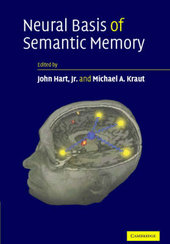
|
Neural Basis of Semantic Memory
Hardback
Main Details
| Title |
Neural Basis of Semantic Memory
|
| Authors and Contributors |
Edited by John Hart, Jr
|
|
Edited by Michael A. Kraut
|
| Physical Properties |
| Format:Hardback | | Pages:394 | | Dimensions(mm): Height 254,Width 181 |
|
| ISBN/Barcode |
9780521848701
|
| Classifications | Dewey:612.82 |
|---|
| Audience | | Professional & Vocational | |
|---|
| Illustrations |
3 Tables, unspecified; 16 Halftones, unspecified; 15 Line drawings, unspecified; 25 Line drawings, color
|
|
Publishing Details |
| Publisher |
Cambridge University Press
|
| Imprint |
Cambridge University Press
|
| Publication Date |
22 March 2007 |
| Publication Country |
United Kingdom
|
Description
The advent of modern investigative techniques to explore brain function has led to major advances in understanding the neural organization and mechanisms associated with semantic memory. This book presents current theories by leading experts in the field on how the human nervous system stores and recalls memory of objects, actions, words and events. Chapters range from models of a specific domain or memory system (e.g., lexical-semantic, sensorimotor, emotion) to multiple modality accounts; from encompassing memory representations, to processing modules, to network structures, focusing on studies of both normal individuals and those with brain disease. Recent advances in neuro-exploratory techniques allow for investigation of semantic memory mechanisms noninvasively in both normal healthy individuals and patients with diffuse or focal brain damage. This has resulted in a significant increase in findings relevant to the localization and mechanistic function of brain regions engaged in semantic memory, leading to the neural models included here.
Author Biography
John Hart is Professor of Behavioral and Brain Sciences and Medical Science Director at The Center for BrainHealth, The University of Texas at Dallas. Michael Kraut is Associate Professor of Radiology at Johns Hopkins University School of Medicine.
Reviews'... the incorporation of data derived from multiple modalities of investigation and the completeness of the arguments discussed make this book a useful reference for neuroscientists involved in clinical and neurophysiological studies. Furthermore this book represents a successful first editorial attempt to approach the neural substrates of semantic memory from a 360 Degrees perspective. Even a nonexpert but motivated reader of this book will be fascinated by the most recent scientific research on where we store what we know, how we store it (e.g. with sensorimotor codes) and finally what is what we know. This book, reporting the results of different types of investigations, is strong evidence to suggest that, piece by piece, we are getting closer to solving the whole puzzle of the semantic brain.' European Neurology
|